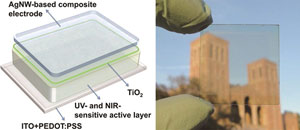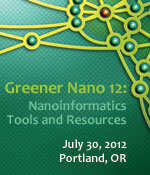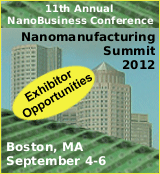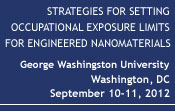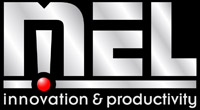| Email not displaying correctly? View it in your browser. |
 Volume
5 Issue 7 - July 2012
Volume
5 Issue 7 - July 2012 |
|
Latest Nanotechnology Signature Initiative Provides for Intriguing Concepts Addressing Critical Challenges 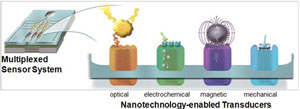
The recently announced Nanotechnology Signature Initiative (NSI), Nanotechnology for Sensors and Sensors for Nanotechnology: Improving and Protecting Health, Safety, and the Environment, is the fifth NSI to be launched by agencies of the National Nanotechnology Initiative (NNI). Sensors incorporating nanostructures and nanomaterials have been under development for over 20 years now, and show the potential to provide significant societal impact through the deployment of inexpensive, simple to use, portable devices that can rapidly detect, identify, and quantify biological and chemical substances. Such sensors would ultimately impact consumer and military applications including medicine and healthcare, biological and chemical warfare threat detection, environmental monitoring, pharmaceuticals, food, and agriculture. Looking through the details of the this NSI, the descriptions of the thrusts and goals provide for some intriguing concepts, and address some critical challenges and barriers to the successful deployment, and ultimately commercialization, of nanosensor technologies. The key thrusts of this NSI include, in some sense, nanosensors monitoring nanomaterials. Rather than conjuring up images of self-monitoring nanomaterials that become self-aware and take over the world, one can focus on the key aspects of this initiative that will lead to the realization of nano-enabled sensing technologies, and improved understanding of nanomaterials and systems to benefit society. Regards, Researchers Create Highly Conductive and Elastic Conductors Using Silver Nanowires
Researchers from North Carolina State University have developed highly conductive and elastic conductors made from silver nanoscale wires (nanowires). These elastic conductors can be used to develop stretchable electronic devices. Stretchable circuitry would be able to do many things that its rigid counterpart cannot. For example, an electronic "skin" could help robots pick up delicate objects without breaking them, and stretchable displays and antennas could make cell phones and other electronic devices stretch and compress without affecting their performance. However, the first step toward making such applications possible is to produce conductors that are elastic and able to effectively and reliably transmit electric signals regardless of whether they are deformed. Dr. Yong Zhu, an assistant professor of mechanical and aerospace engineering at NC State, and Feng Xu, a Ph.D. student in Zhu's lab have developed such elastic conductors using silver nanowires. Silver has very high electric conductivity, meaning that it can transfer electricity efficiently. And the new technique developed at NC State embeds highly conductive silver nanowires in a polymer that can withstand significant stretching without adversely affecting the material's conductivity. This makes it attractive as a component for use in stretchable electronic devices.
Nanotechnology...naturally delicious
Hungry for a little knowledge about the nature of nanotechnology? Good. I've put together a gourmet picnic of tasty facts about nanotechnology that's been on the menu every day, for thousands (and thousands) of years. Yes, nanoscale materials have long been part of our food supply — including the way Mother Nature herself prepared it. Care for a nibble? What's first in our picnic spread? Let's start with bread. It's been nanoenabled since 5500 BC. That when historians say Egyptians started baking it. How do we know? Recent research at the Indian Institute of Technology found that bread develops carbohydrate-based "food caramels" in the process of dry heat baking. Those food caramels contain carbon nanoparticles.
Solution Processing of Transparent Polymer Solar Cells
Polymer solar cells (PSCs) are being actively developed for applications in which large area, high-rate solution based processes provide a low-cost alternative to more traditional photovoltaic device technologies. Progress in PSC performance has demonstrated power conversion efficiency exceeding 10% for tandem device architectures, thereby opening the door for competitive cost-performance trade-off for applications such as building integrated photovoltaics, or chargers for portable electronic devices. A related opportunity is transparent PSCs that could be used to generate power from windows on homes and buildings while still allowing people to see outside. While such a smart window technology for generating electricity could find widespread use, the cost and performance targets are even more critical in order to gain market entry. From a technology standpoint, the PSC would have to convert mainly infrared light to electricity, not the visible part of the spectrum, leaving the cells at least 70% transparent to the human eye, while demonstrating power conversion efficiency approaching that of normal PSCs. For manufacturing, the cells would have to be made through solution processing in order to achieve the necessary economy of scale for market acceptance, while further enhancing the value proposition through an extended lifecycle. All of these are significant challenges for the standard PSCs, let alone the added requirements to achieve transparency.
|
Job Opportunities Analog Circuit Designer-Imagers Nanotechnology Research Engineer Grants/Foundation Administrator, Manager and Writer
Material Scientist Upcoming Events July 30, 2012 August 14-16, 2012 August 20-23, 2012 Upcoming Calls 2012 IEEE Workshop on Nanoinformatics for Biomedicine Nanomanufacturing Summit 2012 Advertisements Recently Published Efficient Light Trapping in Inverted Nanopyramid Thin Crystalline Silicon Membranes for Solar Cell Applications
Development and characterization of a capillary-flow microfluidic device for nucleic acid detection
Microbial Nanowires: A New Paradigm for Biological Electron Transfer and Bioelectronics
Toroidal dipole response in a multifold double-ring metamaterial
A multifunctional poly(aryl ether) with oligoaniline and fluorene pendants: Synthesis, electrochromic performance, and tunable fluorescent properties
Affiliated Centers |
|
Subscribe / Unsubscribe from this list. Our mailing address is: The National Nanomanufacturing Network 374 Lederle Graduate Research Center 710 N. Pleasant Street University of Massachusetts Amherst, MA 01003 Our email address is: nnn@nanomanufacturing.org Our phone number is: (413) 577-0570 Copyright (C) 2012 The National Nanomanufacturing Network All rights reserved. Supported by the National Science Foundation under Grant No. CMMI-1025020. |
|
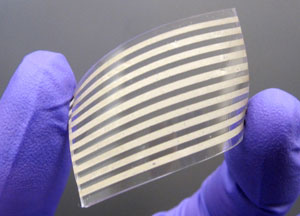
 You're invited to a nanotechnology picnic. Nature will provide the food.
You're invited to a nanotechnology picnic. Nature will provide the food.